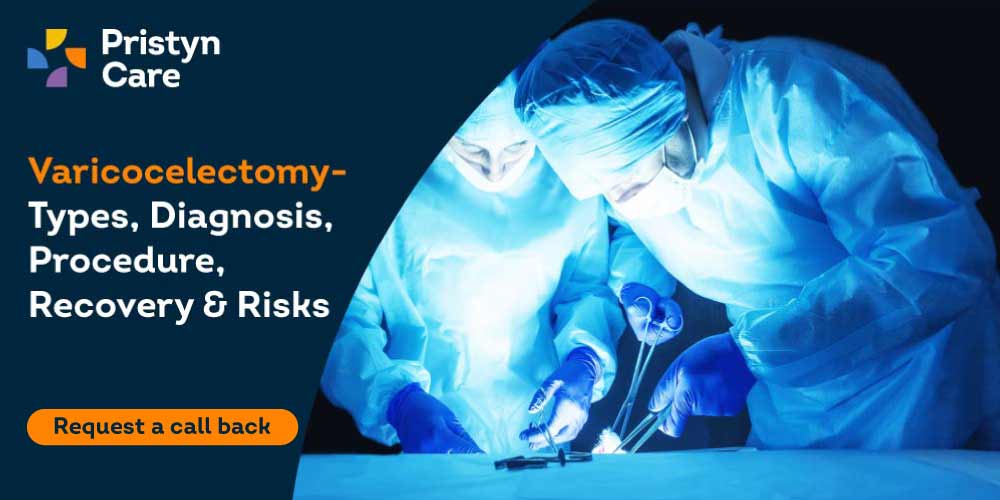![]() Views: 2,611
Views: 2,611
Varicocelectomy- Types, Procedure, Recovery & Risks
A varicocelectomy is a surgical treatment for the removal of swollen or inflamed veins (also called a varicocele) inside the scrotal sac. While traditionally, varicocelectomies were performed through open surgery, nowadays, more conservative treatments such as laparoscopic varicocelectomy and microscopic varicocelectomy are more common.
Dedicated Support at Every Step!
Our Doctors are available 24 hours a day, 7 days a week to help you!
Table of Contents
What is a varicocele?
A varicocele is a collection of inflamed or swollen (varicose) veins inside the scrotum. It generally occurs due to valvular abnormalities in the scrotal veins, which leads to irregular blood flow and pooling of blood in the veins.
Varicoceles block the blood flow in the testes and restrict the blood flow to the testes. They can impede reproductive function and lead to permanent damage to the testicles, also known as testicular atrophy.
No Cost EMI, Hassle-free Insurance Approval
What are the grades of severity of a varicocele?
Based on the results of the physical examination, the different grades of severity of a varicocele are:
Grade 1: The varicocele is only palpable through the Valsalva maneuver. It is not causing any pain, discomfort, or reproductive problems.
Grade 2: Varicocele is easily visible and palpable in a standing position even without the valsalva maneuver. There might not be any pain or discomfort.
Grade 3: Varicocele is easily visible and palpable in all postures and positions, and is causing problems such as testicular atrophy, scrotal pain, azoospermia, etc.
Also Read: Varicocele Grading – When To See A Doctor?
Who needs a varicocelectomy?
Varicoceles are very common. They generally occur in around 15 % of adult men and 20 % of male teenagers. Most commonly, varicoceles occur in teenagers during puberty, but often varicoceles that occur during this time resolve themselves after some time and do not need surgery.
You may need varicocele surgery if:
- you have severe pain in the scrotum due to the varicocele. While varicoceles are generally asymptomatic and do not cause any pain or discomfort usually, sometimes they can lead to extreme pain and discomfort.
- you want to reproduce. The most serious problem related to untreated varicoceles is testicular atrophy. If the testes do not get proper blood flow for a long period, it can lead to permanent damage to the testes.
- you are experiencing symptoms of decreased testosterone production, such as weight gain, low sex drive, erectile dysfunction, low semen production, hair loss, etc.
- the testicular growth in children or teenagers is slow.
- you have a large varicocele causing aesthetic problems.
Types of varicocelectomy
Based on the degree of invasion and the type of instruments used, different types of varicocelectomy procedures are:
- Open varicocelectomy: It is an open surgery in which the surgeon makes an incision on the scrotum, groin, or lower abdomen to find and tie off the varicose blood vessels.
- Laparoscopic varicocelectomy: This procedure is performed by making small incisions in the lower abdomen/scrotum, through which a laparoscope is introduced to see and remove the varicocele. The procedure is outpatient and takes around 30 to 40 minutes.
- Microscopic varicocelectomy: This procedure is similar to laparoscopic surgery. But, the incision is placed on the scrotum and instead of a laparoscope, it is performed using a microscope to identify the varicose veins and distinguish them from normal ones.
Although a little complex, it has fewer complications and lesser recurrence rates compared to open surgery. It is also an outpatient procedure and takes about 2-3 hours to complete.
Also Read: Types Of Treatments For Varicocele And Comparison Between Them
Based on the location of the incision, the types of varicocelectomy are:
- Retroperitoneal high ligation
- Inguinal ligation
- Sub-inguinal ligation
What are the diagnostic tests performed before a varicocelectomy?
- Medical history and general examination: Before the surgery, the surgeon will collect your medical history and perform diagnostic tests to find out if you have any chronic or systemic illnesses. Diagnostic tests before varicocelectomy are blood panel, ECG, urine tests, chest X-ray, etc. Once you’ve been deemed fit for surgery, the surgeon will start preparing your treatment plan.
- Physical examination: A physical examination is necessary to evaluate the severity of the varicocele and finalize the type of procedure to be performed. Generally, it is difficult to evaluate a varicocele lying down, so it is evaluated when the patient is in a standing position.
The physical evaluation of a varicocele is done through a valsalva maneuver. The valsalva maneuver is a breathing method that helps slow down the heart rate and blood flow in the vessels. The patient is asked to breathe out strongly through the mouth while their nose is being held tightly. This creates a forceful strain that triggers the heart and forces it to slow its beating.
- Doppler ultrasound of the scrotum: A doppler ultrasound is performed to determine the extent of dilation of the veins to determine the final course of treatment.
- CT/MRI scan: A CT or MRI scan will be performed to gain better images of the varicose veins if the ultrasound is not clear.
How can you prepare for a varicocelectomy surgery?
Before the surgery, let your surgeon know if you’re taking any medications or supplements. If you are taking any blood thinners, you may have to stop them at least a few days before the surgery to lower the risk of bleeding during the surgery.
You may also be asked to avoid any food or drinks for at least 8 to 12 hours before the surgery. After the surgery, you will not be able to drive yourself home, so you should arrange for transportation once you are done with the surgery.
What happens during a varicocelectomy?
Varicocelectomy is generally performed as an outpatient procedure under general or spinal anesthesia, based on the surgeon/patient preference. The most common varicocelectomy procedure performed nowadays is laparoscopic varicocelectomy.
The procedure of a laparoscopic varicocelectomy is described as follows:
- The surgeon will make several tiny cuts in your lower abdomen. Through one of these cuts, a small laparoscope (camera) is inserted to visualize the internal structures.
- The laparoscope will be used to fill the insides of the abdomen with gas to allow more space for the procedure.
- Through the other cuts, surgical tools for cutting/ligating or tying off the varicose veins. Once the veins are removed, the ends of the veins are sealed off through small clamps or via cauterization.
- All the surgical instruments are removed and the incisions are either sutured or stapled shut.
The sutures/staples are usually removed within 1-2 weeks of the surgery once the incisions have healed sufficiently.
How long does it take to recover from minimally invasive varicocelectomy?
After the procedure is completed, you may be kept under observation for 2-3 hours in a recovery room. If there are no complications, you will be able to go home immediately. Most men can start working within a couple of days of the surgery, especially if they have desk jobs.
However, complete recovery may take at least 3-6 weeks, depending on the type of surgery and the severity of the condition. There may be slight postoperative pain and swelling in the groin for 3 to 4 weeks, but that can be easily resolved through over-the-counter pain medication.
Also Read: How Long Does It Take For Varicocele To Disappear After Surgery?
How to improve recovery after a varicocelectomy?
Once you are discharged, you can follow the following tips to make your recovery faster, such as:
- Keep the incisions dry. If you notice any signs of infection such as redness, discharge, fever, etc., then contact your doctor immediately.
- Do not engage in any strenuous activities or sports for at least 2-3 weeks after the surgery.
- Take your medicines as prescribed by your doctor without fail.
- Apply an ice pack to your scrotum for at least 10 min. Several times a day to keep the swelling down.
- Do not have any sexual intercourse for at least 2 weeks after the surgery.
- Do not swim, take a bath or perform any activity involving immersing your scrotum in water until the incisions have closed.
- Manage your diet to avoid constipation and straining while defecating. You may take a stool softener or muscle relaxer if you have difficulty passing stools.
Your doctor may perform a semen analysis within 3 to 4 months after the surgery to ensure you are recovering properly.
What are the risks associated with varicocelectomy procedures?
Although varicocelectomy is relatively a very safe procedure, just like other surgical procedures, it can be associated with some risks and complications like:
- Hemorrhage
- Infection
- Blood clots in leg veins (Deep vein thrombosis)
- Hydrocele (fluid buildup in the varicocele)
- Difficulty in emptying the bladder/Bladder obstruction
- Injury/damage to the testicle
- Testicular atrophy
- Chronic pain
- Recurrence of the varicocele
You should immediately connect with your doctor if you notice any complications such as:
- Discharge from the incisions
- Fever over 100.4 degrees Farenheit
- Constant pain and swelling that are not relieved by medicines/ice packs, etc.
- Pain and swelling in the legs
- Persistent nausea and vomiting
How does varicocelectomy affect fertility?
Generally, a varicocelectomy is performed to improve fertility by removing the varicocele and restoring the blood flow to the scrotum. As the blood flow improves, sperm and testosterone production improve. For proper evaluation of fertility improvement after surgery, the doctor will perform regular sperm analysis every 2-3 weeks for at least 3 months.
Conclusion
A varicocelectomy is a safe procedure that improves fertility by improving the blood flow near the testes. Various research studies have shown an improvement of at least 20-60% in pregnancy rates in couples after varicocelectomy surgery. Additionally, if left untreated, varicocele can lead to permanent shrinking of testicles, also called testicular atrophy. If you are experiencing any varicocele-related problems, book a free consultation with the best varicocele doctor near you.









